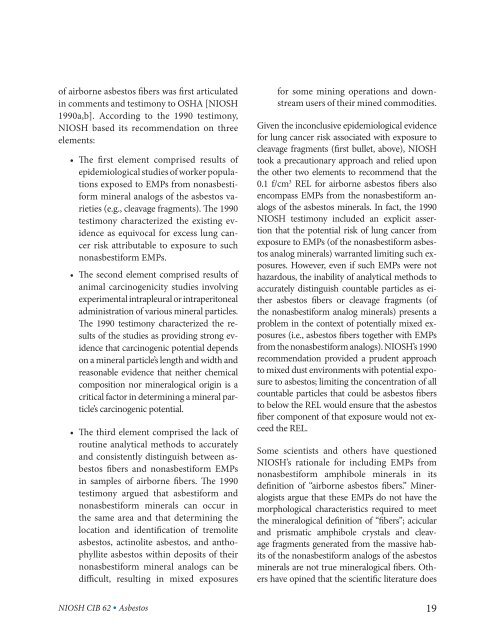Asbestos Fibers and Other Elongate Mineral Particles: State of the ...
Asbestos Fibers and Other Elongate Mineral Particles: State of the ...
Asbestos Fibers and Other Elongate Mineral Particles: State of the ...
- No tags were found...
You also want an ePaper? Increase the reach of your titles
YUMPU automatically turns print PDFs into web optimized ePapers that Google loves.
<strong>of</strong> airborne asbestos fibers was first articulated<br />
in comments <strong>and</strong> testimony to OSHA [NIOSH<br />
1990a,b]. According to <strong>the</strong> 1990 testimony,<br />
NIOSH based its recommendation on three<br />
elements:<br />
• The first element comprised results <strong>of</strong><br />
epidemiological studies <strong>of</strong> worker popula-<br />
tions exposed to EMPs from nonasbesti-<br />
form mineral analogs <strong>of</strong> <strong>the</strong> asbestos varieties<br />
(e.g., cleavage fragments). The 1990<br />
testimony characterized <strong>the</strong> existing evidence<br />
as equivocal for excess lung cancer<br />
risk attributable to exposure to such<br />
nonasbestiform EMPs.<br />
• The second element comprised results <strong>of</strong><br />
animal carcinogenicity studies involving<br />
experimental intrapleural or intraperitoneal<br />
administration <strong>of</strong> various mineral particles.<br />
The 1990 testimony characterized <strong>the</strong> results<br />
<strong>of</strong> <strong>the</strong> studies as providing strong evidence<br />
that carcinogenic potential depends<br />
on a mineral particle’s length <strong>and</strong> width <strong>and</strong><br />
reasonable evidence that nei<strong>the</strong>r chemical<br />
composition nor mineralogical origin is a<br />
critical factor in determining a mineral particle’s<br />
carcinogenic potential.<br />
• The third element comprised <strong>the</strong> lack <strong>of</strong><br />
routine analytical methods to accurately<br />
<strong>and</strong> consistently distinguish between asbestos<br />
fibers <strong>and</strong> nonasbestiform EMPs<br />
in samples <strong>of</strong> airborne fibers. The 1990<br />
testimony argued that asbestiform <strong>and</strong><br />
nonasbestiform minerals can occur in<br />
<strong>the</strong> same area <strong>and</strong> that determining <strong>the</strong><br />
location <strong>and</strong> identification <strong>of</strong> tremolite<br />
asbestos, actinolite asbestos, <strong>and</strong> anthophyllite<br />
asbestos within deposits <strong>of</strong> <strong>the</strong>ir<br />
nonasbestiform mineral analogs can be<br />
difficult, resulting in mixed exposures<br />
NIOSH CIB 62 • <strong>Asbestos</strong><br />
for some mining operations <strong>and</strong> downstream<br />
users <strong>of</strong> <strong>the</strong>ir mined commodities.<br />
Given <strong>the</strong> inconclusive epidemiological evidence<br />
for lung cancer risk associated with exposure to<br />
cleavage fragments (first bullet, above), NIOSH<br />
took a precautionary approach <strong>and</strong> relied upon<br />
<strong>the</strong> o<strong>the</strong>r two elements to recommend that <strong>the</strong><br />
0.1 f/cm 3 REL for airborne asbestos fibers also<br />
encompass EMPs from <strong>the</strong> nonasbestiform analogs<br />
<strong>of</strong> <strong>the</strong> asbestos minerals. In fact, <strong>the</strong> 1990<br />
NIOSH testimony included an explicit assertion<br />
that <strong>the</strong> potential risk <strong>of</strong> lung cancer from<br />
exposure to EMPs (<strong>of</strong> <strong>the</strong> nonasbestiform asbestos<br />
analog minerals) warranted limiting such exposures.<br />
However, even if such EMPs were not<br />
hazardous, <strong>the</strong> inability <strong>of</strong> analytical methods to<br />
accurately distinguish countable particles as ei<strong>the</strong>r<br />
asbestos fibers or cleavage fragments (<strong>of</strong><br />
<strong>the</strong> nonasbestiform analog minerals) presents a<br />
problem in <strong>the</strong> context <strong>of</strong> potentially mixed exposures<br />
(i.e., asbestos fibers toge<strong>the</strong>r with EMPs<br />
from <strong>the</strong> nonasbestiform analogs). NIOSH’s 1990<br />
recommendation provided a prudent approach<br />
to mixed dust environments with potential exposure<br />
to asbestos; limiting <strong>the</strong> concentration <strong>of</strong> all<br />
countable particles that could be asbestos fibers<br />
to below <strong>the</strong> REL would ensure that <strong>the</strong> asbestos<br />
fiber component <strong>of</strong> that exposure would not exceed<br />
<strong>the</strong> REL.<br />
Some scientists <strong>and</strong> o<strong>the</strong>rs have questioned<br />
NIOSH’s rationale for including EMPs from<br />
nonasbestiform amphibole minerals in its<br />
definition <strong>of</strong> “airborne asbestos fibers.” <strong>Mineral</strong>ogists<br />
argue that <strong>the</strong>se EMPs do not have <strong>the</strong><br />
morphological characteristics required to meet<br />
<strong>the</strong> mineralogical definition <strong>of</strong> “fibers”; acicular<br />
<strong>and</strong> prismatic amphibole crystals <strong>and</strong> cleavage<br />
fragments generated from <strong>the</strong> massive habits<br />
<strong>of</strong> <strong>the</strong> nonasbestiform analogs <strong>of</strong> <strong>the</strong> asbestos<br />
minerals are not true mineralogical fibers. <strong>O<strong>the</strong>r</strong>s<br />
have opined that <strong>the</strong> scientific literature does<br />
19

















